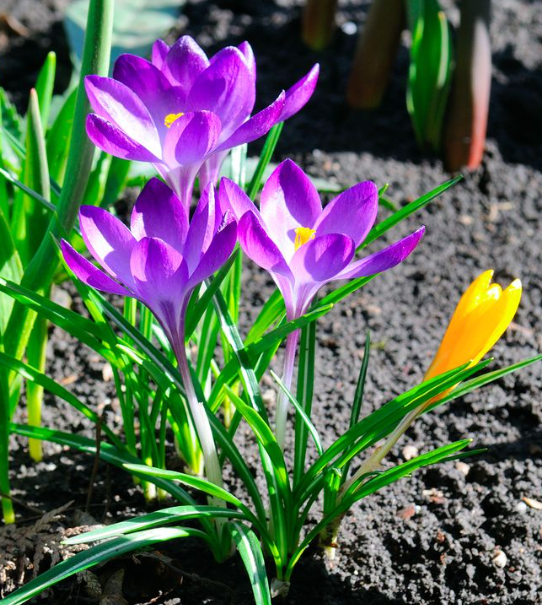Subtotal $0.00
If you garden in a warm climate like I do (zone 9), you might be wondering how to successfully grow spring bulbs. While it’s best to plant bulbs by December to give them ample time to chill, there’s still time to get them in the ground, especially if you’re a little behind schedule, like I am this year. This post is all about my favorite spring bulbs for warmer climates and how I incorporate them into my garden design.
Understanding Winter Chill and Its Importance
In many regions, winter chill is necessary for bulbs to bloom. However, for those in warmer areas, it can be a bit tricky since many bulbs require colder temperatures to enter dormancy and thrive. Some, like tulips and daffodils, need 12+ weeks of soil temperatures below 40°F to bloom properly, while others, such as snowdrops and muscari, need much less.
Since I live in a mild climate, I can plant bulbs that require less chilling time. Bulbs like cyclamen, snowdrops, and crocus are a perfect fit for warmer winters, as they need only minimal cold to bloom in early spring.
Planting Bulbs Like Ephemerals
I often treat bulbs as if they are ephemerals. Ephemeral plants are those that bloom briefly in early spring before disappearing as the warmer weather arrives. I plant these bulbs under deciduous trees or large shrubs, where they can bloom before the canopy fills in with leaves. For instance, the native calycanthus ‘Aphrodite’ is a perfect example of a shrub that offers beautiful blooms in spring, leaving a blank space in winter. This spot is ideal for early bulbs like snowdrops, muscari, or narcissus.
Hiding Bulb Foliage
After bulbs bloom, their foliage tends to look a bit unsightly, especially as it begins to yellow and die back. However, it’s essential to leave the leaves in place as they are storing energy for next year’s flowers. To manage this, I plant bulbs behind low-growing shrubs or perennials that can hide the aging foliage. For instance, I’ve planted narcissus varieties like ‘Yaz’ and ‘Blushing Lady’ behind grevillea ‘Mt. Tamboritha’. This way, as the bulb leaves begin to droop, I can easily tuck them behind the foliage of the grevillea until they wither away.
Planting Bulbs in Drifts
To make a bold statement in your garden, plant bulbs in drifts. I always recommend planting a dozen or more of each variety for a striking display. One way to create a more natural look is by tossing bulbs in a loose grouping and planting them where they land. This informal method yields a more authentic, beautiful result compared to arranging bulbs in neat rows or patterns.
For digging bulb holes, I rely on tools like the Cobrahead weeder, which is great for creating fast, clean holes with ease. The Cobrahead is not only efficient but also incredibly satisfying to use, making bulb planting a quick and enjoyable task.
Staggering Bloom Times
One of the best ways to extend the beauty of spring bulbs is by staggering their bloom times. Early bloomers like cyclamen, snowdrops, and crocus are the first to appear, followed by narcissus, jonquils, and tulips. As these fade, later bloomers such as scilla, gladiolas, calla lilies, and alliums take center stage.
When planting in containers, I practice “lasagna planting,” layering bulbs based on their bloom times. For example, I’ll plant tulips in the bottom of the container and cover them with crocus for a succession of blooms. It’s an easy method that creates a continuous show of flowers.
My Favorite Spring Bulbs for Warm Climates
Here are a few of my top picks for spring bulbs that thrive in warm climates:
1. Species Tulips
Species tulips are smaller, daintier varieties that don’t require as much winter chill. Varieties like Tulipa saxatilis, Tulipa clusiana, and Tulipa sylvestris naturalize easily, forming charming colonies that last for years.
2. Narcissus (Daffodils and Jonquils)
While many daffodils need a cold winter, varieties like Narcissus ‘Bantam’, ‘Avalanche’, and ‘Thalia’ thrive in warmer climates and come back year after year.
3. Leucojum aestivum (Snowflakes)
These relatives of snowdrops bloom with large, nodding white flowers and quickly spread to form lovely drifts in the garden. They are deer-resistant, which makes them even more appealing.
4. Crocus
Crocus is one of the first bulbs to bloom in spring, although they can be finicky in warmer climates. Despite the challenge, I find them worth planting for their early, colorful blooms.
5. Liatrus (Blazing Star)
This perennial bulb blooms late in spring and pairs beautifully with late tulips. The flowers bloom from the bottom of the stalk upwards, creating a unique floral display.
6. Byzantine Gladiolus
With its hot magenta flowers, this gladiolus variety adds a pop of color in late spring. Their smaller blooms make them perfect for warm gardens, and they stand out beautifully in larger spaces.
7. Muscari (Grape Hyacinths)
Muscari is a low-growing, prolific bulb that colonizes quickly and provides vibrant blue flowers. They’re excellent for creating colorful clusters in the garden.
8. Zantedeschia albomaculata (Spotted Calla Lily)
This variety of calla lily features vibrant flowers and speckled foliage that add texture and beauty to any garden. It’s easy to divide and spread, providing months of enjoyment.
9. Asiatic Lilies
These lilies bloom in late spring and are perfect for warm climates, as they don’t require winter chill. Their bright colors make them a striking addition to any garden.
10. Zephyranthes (Rain Lily)
Rain lilies are fascinating bulbs that stay dormant for most of the year, only blooming after rainfall. Their cheerful yellow and white flowers are a welcome sight after a storm.
11. Sparaxis elegans (Harlequin Flower)
Sparaxis provides an explosion of color in early spring, making it an excellent choice for adding vibrancy to your garden.
Conclusion
Designing a spring garden in a warm climate requires a thoughtful selection of bulbs that can thrive without the need for harsh winter chill. By choosing the right varieties and planting them with care, you can enjoy a beautiful and long-lasting bloom season that supports pollinators and enhances your garden. Happy planting!












